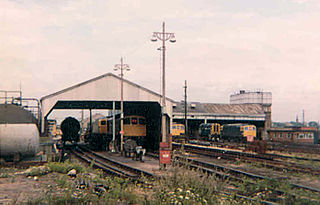
A motive power depot (MPD) or locomotive depot, or traction maintenance depot (TMD), is where locomotives are usually housed, repaired and maintained. They were originally known as "running sheds", "engine sheds" or just "sheds". Facilities are provided for refuelling and the replenishing of water, lubricating oil and grease and, for steam engines, the disposal of ash. There are often workshops for day-to-day repairs and maintenance, but locomotive building and major overhauls are usually carried out at locomotive works.
British Rail Class D3/14 was a diesel-electric locomotive built by the London and North Eastern Railway at its Doncaster Works. It had a Petter engine, and Brush Traction electricals. It was absorbed by British Railways on nationalisation, but was withdrawn in the pre-TOPS era.

Darnall DMU Depot was a traction maintenance depot in Darnall, Sheffield, England. It was built by the London and North Eastern Railway to serve the Sheffield area, passenger trains originating or changing at Sheffield Victoria and goods and pilot workings. The shed was built adjacent to the main line immediately west of Darnall station. British Railways initially allocated the shed code 39B to Darnall, and later 41A, both within the Eastern Region code sequence.

Immingham engine shed, also known as Immingham depot, or more recently as Immingham TMD and always locally as Loco is a railway maintenance depot located on the Immingham Dock estate, in North East Lincolnshire, England. The depot code is IM.

Gateshead TMD was a railway traction maintenance depot situated in Gateshead, England. The depot code was 52A during the steam era and GD later on.

Neville Hill is a railway train maintenance depot in Osmondthorpe, Leeds, England on the Leeds to Selby Line. The depot is situated 2 miles 14 chains (3.5 km) to the east of Leeds railway station on the north side of the line.

Penzance TMD, also known as Long Rock TMD, is a railway traction maintenance depot situated in the village of Long Rock east of Penzance, Cornwall, England, and is the most westerly and southerly rail depot in the country. The depot operator is Great Western Railway. The depot code is PZ.

Hither Green (London) Traction Maintenance Depot or Hither Green (London) TMD is a railway depot used for the maintenance and servicing of freight trains adjacent to the Hither Green marshalling yard. The depot is a hub for moving freight around southeast England. Hither Green TMD is owned and operated by DBS. The official depot code is HG. In steam days the shed code was 73C.

Mexborough engine shed was an engine shed in Swinton, in South Yorkshire, England. It was built by the Great Central Railway and opened in 1875. The shed was built slightly to the west of the current Mexborough station on land between the River Don and the River Don Navigation. It had 15 dead end roads, and could handle about 150 steam locomotives, mainly for use on freight trains. The London and North Eastern Railway operated the shed from 1923. In 1948, on the formation of British Railways Eastern Region, Mexborough bore the shed code 36B, then 41F from 1958. It closed in February 1964.

Stratford Works was the locomotive-building works of the Great Eastern Railway situated at Stratford, London, England. The original site of the works was located in the 'V' between the Great Eastern Main Line and the Stratford to Lea Bridge route and in the early years was also the home of Stratford Locomotive Depot. The final part of the works closed in 1991.

Stratford TMD was a traction maintenance depot located in Stratford, London, England close to the Great Eastern Main Line. It was located just west of Stratford station, on a site now occupied by Stratford International station. The depot was at one time the biggest on the London and North Eastern Railway with locomotives covering duties from express services to freight workings in London's docks.

Shrewsbury TMD is a railway traction maintenance depot (TMD) situated in Coleham, Shrewsbury, England. The TMD forms part of Coleham Depot, a permanent way depot operated by Network Rail. The code for the TMD is 'SB'.
There were a number of engine sheds and railway works located in York. The large York North engine shed became the National Railway Museum in 1975.

Ipswich engine shed was an engine shed located in Ipswich, Suffolk on the Great Eastern Main Line. It was located just south of Stoke tunnel and the current Ipswich railway station. Locomotives accessed the site from Halifax Junction which was also the junction for the Griffin Wharf branch of Ipswich docks. The depot opened in 1846 and closed in 1968 although the site remained in railway use for a further thirty years.
Norwich engine shed was located in Norwich, England and was opened in 1843. It closed in 1982 and was replaced by a new modern facility at Crown Point.

Botanic Gardens TMD is a traction maintenance depot in Kingston upon Hull in Yorkshire, England. As built it was one of the principal steam engine sheds in the Hull area, Botanic Gardens was the one closest to the main Hull Paragon station and its locomotives were responsible for working passenger services in the area. This entry also covers the engine sheds in the Paragon area that preceded Botanic Gardens.
Colchester engine shed was a motive power depot located in Colchester in the county of Essex in the UK. The original depot dated back to the opening of the Eastern Counties Railway (ECR) in 1843 and a second engine shed was built following the opening of the Eastern Union Railway in 1846. The ECR shed closed and the EUR shed was in use until November 1959 when the line was electrified and Colchester station rebuilt. A smaller two track engine shed was provided south of the station and after closure in the 1990s it was used for the stabling of diesel and electrical multiple units. It is currently known as Colchester Carriage Servicing Depot and units can be washed externally and cleaned internally on site.

Blyth Cambois TMD was a traction maintenance depot located in Blyth, Northumberland, England. The depot was situated on the west side of the branch line from Bedlington Junction to Blyth Docks.

Wigan Springs Branch TMD is a traction maintenance depot located in Ince in Makerfield, near Wigan, Greater Manchester, England. There has been a Motive power depot in the area of the current depot since the 1840s.


















